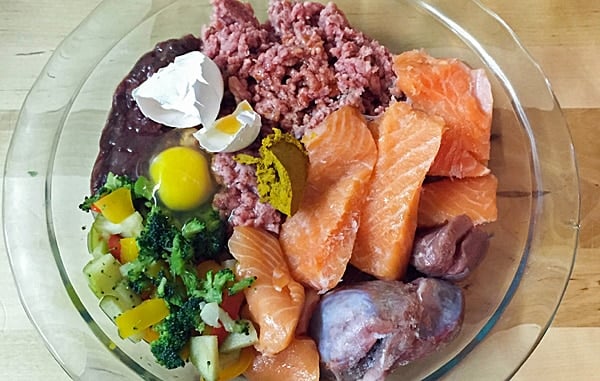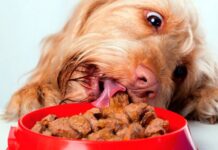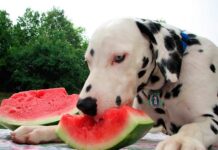You’ve probably heard of the BARF diet for dogs on some occasion, also known as Biologically Appropriate Raw Foods or a natural diet of raw foods. We’ll explain in detail what it is, its benefits and some of the best recipes. If you’re really worried about giving your best friend/pet/dog a proper diet, there’s nothing better than this method of feeding.
Starting at the beginning and so there are no misunderstandings, we must remember that the dog is a direct descendant of the wolf. Trained and socialized for centuries, they evolved into what we now know as dogs or domesticated animals. There are a thousand types because of the many crosses and even genetic manipulations that have been made over the years, but the only ancestor of the dog is the wolf.
Knowing this, let’s get to what really interests us…What do wolves eat? Wolves don’t eat kibble or dog biscuits; they eat what they hunt. They are carnivores that feed on their prey. The same goes for dogs; if we let them into the woods for a long period of time, their most primitive survival instincts will lead them to start hunting again, also feeding on their prey.

When a dog or wolf eats its prey, it’s usually smaller mammals, like rabbits, hares, fawns, sheep, etc. Their prey is usually vegetarian, so the dog or wolf not only eats meat, but also what their prey has in its stomach at the moment, usually some plant food. With this it follows that the main sources of food for dogs or wolves in the wild are meat and bones with a small amount of vegetables and fruits that dogs can eat (those which might be in the stomach of their prey).
This is without a doubt the best example for you to understand that your pet or best friend is a carnivore, and as such, their diet should be based mainly on meat intake. A small vegetable supplement will be suitable as an accompaniment, but always in small quantities.

The BARF diet is a philosophy of food for our pets. With commercial dog food (known as “balanced” in many countries) we are feeding them… but with the BARF diet, we are feeding them properly, as we would our own children. Raw meat with meaty bones and some vegetables is all they need for a complete and balanced diet. Mainly based on proteins, our dogs will become strong and muscular, not mushy like with fatty industrial dog food.

How do you do the BARF diet?
It’s really simple; you just need the raw materials, meat and meaty bones. You can get them from the butcher, slaughterhouse, etc. You don’t have to buy or tenderloin or filet mignon; leftover meat from cutting and organ meats will be sufficient. As for bones, you should always use the tender (fleshy) ones, which are those that make up chicken or turkey carcasses, for example. They are tender bones that can be easily digested and get all their nutritional benefits. Remember never to cook the meat or bones (mainly the bones, because they will splinter and could choke your dog).
The amount varies depending on the weight of your dog, so you should give them 2% to 3% of their total weight in two meals (one in the morning and one at night), depending on how energetic they are. If your dog eats three times a day, you can keep giving him three meals without any problem; simply divide the amount of food in three. If you have a dog that weighs 60 lbs, you should give a feeding in the morning of 0.75 lbs and one at night of 0.75 lbs (daily total = 1.5 lbs which is 2.5% of 60 lbs approx.). In puppies, the proportion is 10% of their total weight and 2% or 3% in adult dogs.
Here we have a little guide of raw ingredients that can be used to develop your dog’s BARF diet, but if you are really interested you won’t want to miss: BARF Diet Recipes.
1. Meaty bones:
You may have never heard of this concept since it’s fairly technical, but you’ll definitely understand what I’m talking about. These are chicken or turkey necks, chicken wings, drumsticks, poultry carcasses, pork ribs, lamb shanks, etc. As you can see, I’m talking about any parts of a prey animal that are made up of relatively soft bone covered with a certain amount of meat. It’s a very affordable food that’s easy to find.
2. Meat and fish:
Take advantage of the sale items at the butcher and use the widest possible variety of chicken, turkey, beef, pork, etc. Regarding fish, the best way is to give them whole pieces (with head, tail, guts and bones), and for this reason sardines and mackerel are convenient and also affordable.
3. Organ meats:
Liver, kidney and hearts are the kings of this food group. The easiest to find are chicken organs, but ask your butcher and you just might find these parts from other animals too.
4. Vegetables and fruits:
These are not a major food group for our pets, but they can provide some nutrients, which is why we add them to their diet in small amounts. You can use spinach, carrots, bell peppers, zucchini, broccoli, cauliflower, ginger, beet, celery, cabbage, squash, apples, pears, banana, etc.
5. Extras:
We can use natural foods to enhance their diet and improve it. For example, we can use herbs like parsley, basil or mint, as well as garlic, olive oil, plain yogurt without additives or unsalted fresh cheese. Eggs can also be included in their diet since they are a source of high quality protein.

To prepare the recipes, remember that you can prepare a lot of food and freeze it in single serving bags (available in any supermarket). It will be much more convenient to take bags out of the freezer for the next day than to prepare food every day. If you take out two or three portions for the next day the night before, you’ll always have your BARF diet ready for your dear companion.
Here is an example of one of many BARF diets that you can find on the internet through Google search, for example. You can change the foods and proportions, always keeping at least a minimum percentage of meat/fish so they get enough protein.
Diet #1 – Golden Retriever, 120 lbs
Raw meaty bones (RMB) meal – 1 lb of chicken backs, or 12 chicken necks, or 8 chicken wings, or 2 beef ribs plus 1 egg or yogurt. You can use lamb, but it’s very rich and could cause indigestion at first. Rack (ribs) of lamb (doesn’t have to be suckling) has very soft bones and that’s what I use if I can find them. Occasionally (maybe once every 2 weeks), I substitute it for fish – either mackerel or canned sardines since my dogs only like those. If your dog likes other types of fish, use those. I divide one big can or two small ones among my 4 dogs (golden, poodle, cocker spaniel and chihuahua).
Meat meal – these amounts are for 1 meal or ½ day – 1 ¼ cup beef heart or chicken gizzards. If I can get kidney, I cut it in pieces and add it to any of the other foods. Most dogs don’t like the way it tastes.
Vegetable meal – this is for 1 meal, not a whole day – ¼ beef liver or one egg and I make ¾ cup of pureed vegetables. Mix and vary the vegetables, don’t try to use them all at the same time – carrots, green beans, yellow squash, zucchini, lettuce, celery – I add a tiny bit of spinach, chard or broccoli. Occasionally if I have a piece of cauliflower I’ll add that too.
I add a teaspoon of quality cold pressed oil to most meals (linseed/flax seed, sunflower or olive, but usually flax seed for the Omega 3s).

If you have a blender, it will be much easier to chop all the vegetable ingredients and store them in the freezer. Another option is to buy a ready-made BARF diet so you only have to thaw and serve it to your beloved dog, although it’s always much better to buy the ingredients yourself and prepare the diet because you can make sure that everything is high quality and properly portioned.
Maybe this seems too complicated or too much hassle to feed your dog. Don’t fool yourself; dog food (manufactured food) is the worst food you can give to your pets. It’s very convenient to take the kibble out of the bag and put it in the bowl, yes, but it’s not healthy at all. Check out how dog food is manufactured, and you’ll be shocked and never buy that kind of “food” for your dog again, since most are of terrible quality.
But if you still want to have the option of commercial dog food, you should read the following article which explains very simply how to identify a dog food of very poor quality vs. one of good quality: How to tell if a dog food is high quality.
What are the benefits of a BARF or raw food diet?
- Shinier coat
- Fresh breath
- More active, better mood
- Won’t smell like “dog”
- Clean teeth without tartar
- More compact, less smelly stool
- Drink less water
- Better muscle development and less body fat
- In animals with joint problems, fairly significant relief
- Fewer allergies and other illnesses
And this is just the beginning. In the long term, they develop far fewer illnesses and their immune system is much stronger. Natural food is without a doubt the best option for both our pets and ourselves. Nature is wise, never forget it.

Why doesn’t my trusted vet recommend this type of food?
Sometimes it’s due to ignorance, since they are animal “doctors”, not nutritionists. Other times, it’s because of financial interest since they earn a percentage of money for each bag of dog food they sell. But if you prepare your own food for your dog, how does that benefit them? But don’t think badly of them; it’s their job, and they have to make a profit to stay in business.
On the other hand, the impressive and misleading advertising campaigns by the major brands of manufactured dog food are enough to confuse and blind even the most intelligent of people. Don’t forget that behind these campaigns, there are dozens of people who dedicate themselves to it, to sell using Marketing. Don’t believe anything in advertisements; do your research and look for accurate data (on the internet you’ll find a lot of information). You’ll see with your own eyes what’s behind these prefabricated dog foods (industrial food).
Interestingly there are many brands of dog food that provide cash (donations) and other means to veterinary schools…isn’t that odd?
Will my dog want to eat my children or my neighbors if I feed him raw meat?
This is a rather absurd question whose answer we all know, but for those who still have doubts… NO. Absolutely nothing bad happens because we feed our dogs properly. They know perfectly well the difference between what is food and what is a person. They will never attack a person to eat just because they’re eating a natural diet like BARF; it’s completely ridiculous. If your dog bites a person, it’s because he isn’t properly taken care of or educated/trained or because that person attacked or frightened him. It will never be because of the type of food you are giving him.

Dogs with digestive problems assimilate natural food better than industrial food (dog food). The BARF diet will be great for them as their need for digestion will be thankfully reduced. Eating industrial food, a dog takes between four and eight hours to digest (my god, how ridiculous is this type of food?). Eating the BARF diet, digestion is reduced to one or two hours. This data alone says a lot about the kind of food it is.
Are there any health risks to my dog from eating raw food?
Raw food can contain bacteria, which usually are destroyed during the dog’s digestion by its stomach acid. There is always a small risk that the bacteria can proliferate, but it’s usually more because of giving them bad meat or whole eggs (the eggshell may contain very harmful bacteria such as salmonella), than the raw meat itself.
That’s why we recommend, on an individual level, to freeze the food for a few days to prevent infections from any possible bacteria. Personally, we don’t freeze our meat and have never had a problem, but that doesn’t mean it can’t happen. We give eggs without the shell since they get all the calcium they need from meaty bones.
However, this is an informational website. We don’t sell the BARF diet or force anyone to give it to their pets. We invite you to find more information on the internet about this type of diet before starting it, because for all the reviews that are in favor of it, there are many others who are against it, too. Ours is obviously in favor… in case you missed that.





